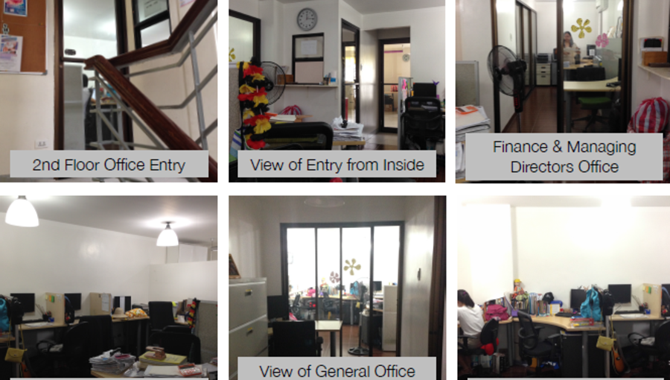
Smokey Mountain
One of the surveyed offices was a non-profit organization that serves an extremely impoverished community in the Smokey Mountain garbage dump. The workplace environment fails to take everyday tasks and habits into consideration, such as the need for hygienic standards and eating facilities. The space is subdivided into mono- functional areas that accommodate mutually exclusive uses and users, including a main workroom, management, finance, a pantry and a computer room for students. This layout is prescriptive and therefore allows little room for adaptation. Because the interface between the outside and inside of the office is not mediated, natural lighting is lost and artificial lighting is inefficiently overused. Employees are generally passionate about their work, but feel tired. A more imaginative workspace could result in spatial efficiencies and inspire the staff to work at their full potential.
The Baranggay
Another workspace in Manresa, Quezon City is one of the 1,700 local administrative divisions, known as the Baranggay. Utilizing these headquarters, the local government addresses daily neighbourhood and community issues. The barangay is historically relevant to the Philippines not just because it dates back to pre- colonial times, but also because it is a uniquely Filipino development. Community members regularly visit the Baranggay to voice public concerns. They enter through a glass door, which is the main source of daylight. There is therefore a practical and symbolic value to the entryway. Artificial lighting fixtures in the rest of the office cannot be adjusted for specific tasks or for collaboration among co- workers. Employees were also interested in giving the office a more professional feel by replacing naked light bulbs with fluorescent fittings.
Hot Off the Press
The headquarters of one of the Philippine’s oldest newspapers is tucked away within the walls of Intramuros, one of the most historically significant sites of the country. The building is protected by the Philippine National Historical Society and houses 15 staff members, including writers and editors, photographers and artists, as well as administration. Writers are constantly on the go, sourcing stories found outside the office and rushing in to finish them before they go to print. Like most newsrooms, schedules must be flexible to fit hasty deadlines and deliver on time. Working out of a historical landmark is always a challenge, as the spaces are out- dated and often unsuitable for today’s work dynamic. Lighting design is no exception! In the newspaper office most employees have no direct access to natural light, only the editor. Artificial lighting fixtures are out- dated, which in turn affects the comfort and performance of the staff. The varied nature of each employee’s work and their changing schedule makes it especially important to design an environment that can adjust to individual needs and time constraints.
Teaching in Caloocan City
A faculty office in a Catholic school adds another perspective to our Lighting the Global Workspace research. Located in Caloocan City in Manila, this workspace is where teachers prepare their lessons and retreat from daily teaching activities. Because of the varying schedules, the office is rarely crowded. Teachers work independently and socializing is done preferably outside. Nevertheless, different activities take place regularly throughout the day and the office is constantly transformed to accommodate them. Prayers are held every morning and Zumba dancing is offered once a week on Fridays as part of their physical fitness program.
Teachers all work with desktop computers, laptops, smart phones and regular phones, most of which they own and take with them at the end of the day. Despite the individualized schedules and technologies, general lighting is bright and intense. It cannot be used task-specific work. Teachers report that lighting influences the work in such a way that it sometimes gives them migraines.
A Pawnshop in Paranaque City
Another establishment surveyed in Manila is a Pawnshop located across from a market in Paranaque City, Metro Manila. According to the Annual Survey of Philippine Business and Industry (ASPBI), Pawnshop operations have the highest number of registered establishments with almost fifty percent of the financial intermediation industry. The workplace has an open plan that is divided into three sections – the receiving counter, the appraisal desk, and the storage space. The receiving counter in the front most part faces the only window in the space. Behind a wall is the storage space, which is open to the appraisal desk on the farthest part.
During an interview, the owner and operations manager discovered that the open plan is actually a challenge to the lighting of the space. The pawnshop operates from morning until night, but the reach of natural light is directly related to the time of the day. This worsens during the rainy season when there is not enough sunlight to light up the interiors. To resolve the lighting limitations walls were painted white and beige. The owner wishes she had a bright and spacious office was more flexible and had space for the employee’s lockers.


